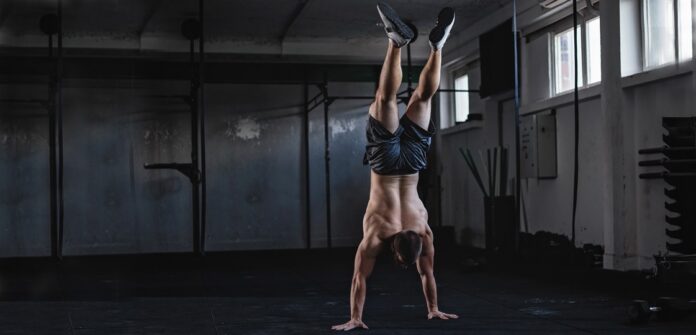Walking on your hands develops strength in the shoulders and wrists, and gives your core a good workout as you balance yourself. Bonus: it’s a really great party trick. It’s not something you just want to jump straight into though. One false move and you might injure your wrists or drop yourself right on your head. To stay safe, work through these progressions one-by-one and warm up thoroughly before each session.
HANDSTANDS AGAINST A WALL
Stand with your back to a wall and put your hands on the ground. Then walk your feet up the wall and move your hands a little closer to the wall. The goal is to hold this position for 60 seconds in one attempt. If you find this really hard, move your hands further away from the wall.
WALL WALKS
When you can hold a static handstand, start walking sideways along the wall. The goal is a full 60 seconds of walking. Aim for four sets of 15 seconds at first, then two sets of 30 seconds, then build up to one set of 60 seconds. When you can do this, move on to the next exercise.
UNASSISTED HANDSTANDS
Stand facing a wall and put your hands down about one foot away from it. From here, try to swing your legs up into the handstand position. Don’t worry about falling—if you overshoot the mark, you’ll just hit the wall. If you undershoot, you’ll land back on your feet. Try to land in the handstand position and hold it for 60 seconds.
PRACTICE FALLING
Put some mats down and practice falling from a handstand in various directions. If you feel you have overshot the mark, put your weight more on to one hand and lower your leg on the same side. If you time this right, you’ll simply tip to the side and land on your feet. You should also practice tipping forward into a forward roll. Move on when you’ve mastered this.
WALK ON YOUR HANDS
Your shoulders, wrist and core are strong. You’ve improved your balance. You know how to fall safely. It’s sink or swim time! Put some mats down, get into a handstand, then try to walk. From here it’s just a matter of sweat and practice, but if you’ve put in all the above groundwork, you should pick this up quickly.
TAKE YOUR TIME
It might take 6-12 months to work through these steps, but they are important because they strengthen the ligaments and tendons in your wrists. These fibers do not develop as quickly as muscles, so you need to give them time to catch up. If you follow the progression set out here, it might take you longer, but you’ll still be able to use your wrists in your 70s… which is always a plus.
The post How to Walk on Your Hands – A Beginner’s Guide appeared first on FitMinutes.









